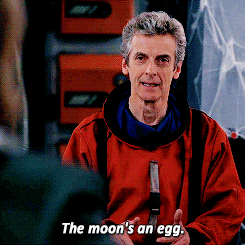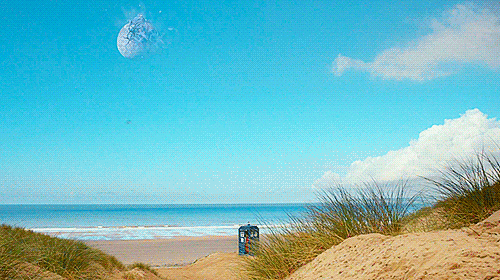Doctor Who Season 8 Episode 7: "Kill the Moon"
The Moon. Its always been there, in constant orbit around the Earth. Humans have always looked to it in wonder, a handful actually gracing its rocky surface at one time or another in an attempt to understands its existence. It is very important too, its varying gravitational pull controls the tides if Earth's great bodies of water. But if the Moon is not what we think it is, what it never was? What would you do if you heard these words?

Yeah, that sounds pretty ridiculous. However the plot of this episode of Doctor Who revolves around (see what I did there?) the idea that the Moon is actually the egg for a giant, ancient space creature. As one could imagine, the laws of physics are both stretched and broken in this episode.
Lets start with this:

On the Moon, the Doctor can make a yo-yo go down and come back up. The acceleration due to on the Moon should be significantly smaller than that of Earth, they should all be floating around and falling very slowing. In effect, the "hatching" of the Moon is causing the force of gravity on the Moon to increase. That means the Moon would have had to gain weight. More specifically, the Moon would have had to gain mass. The equation for acceleration due to gravity is  where G is the universal gravitational constant, M is the mass of the celestial object (the Moon in this case), r is the radius of Moon, and g is acceleration due to gravity. Normally, the Moon's acceleration due to gravity is roughly 1/6th of Earth's, or around 1.62 m/s2. In the curious case of the egg-Moon, this increased significantly to essentially mimic that of Earth. All of this, by the way, would only be possible if the Moon had collided with another celestial body of large enough mass that together they could create a large enough acceleration due to gravity. But this has not occurred, and so the cause of this change in acceleration due to gravity remains a mystery.
where G is the universal gravitational constant, M is the mass of the celestial object (the Moon in this case), r is the radius of Moon, and g is acceleration due to gravity. Normally, the Moon's acceleration due to gravity is roughly 1/6th of Earth's, or around 1.62 m/s2. In the curious case of the egg-Moon, this increased significantly to essentially mimic that of Earth. All of this, by the way, would only be possible if the Moon had collided with another celestial body of large enough mass that together they could create a large enough acceleration due to gravity. But this has not occurred, and so the cause of this change in acceleration due to gravity remains a mystery.
Next we have the fact that the Moon disintegrates in the sky as it hatches and yet nothing occurs on Earth between the time it takes for the recently born creature to lay a second egg-Moon.

After doing some research, this is surprisingly accurate. If the Moon were to disappear the main issues would occur in the long term. Without the gravitational pull of the Moon, the tides would follow the sun which would mean high tide would always be a noon, but given the unknown location where the Doctor landed, this might not be apparent where they are. In the long term, the lack of the Moon's gravitation pull could cause the Earth's rotation about it axis to become more wild- like that of Mars- causing more extreme seasons. But none of this would be apparent in the relatively short amount of time it takes for the creature to lay a new egg where the Moon used to be.

That brings up the question of how on Earth the creature could have laid a new Moon exactly where the old Moon had been. It might not of. If the Moon were to be closer to the Earth it would increase its gravitational exertion on the Earth. This would result in low tides would be lower and high tides would be higher and any low lying coastline would be flooded. The opposite would be true if the Moon were moved further away- the high tides would become lower and low tides would become higher until they were essentially equal. Another impact of the Moon moving further away would be the slowing of Earth's rotation about its axis, lengthening the amount of time in a day. But it is not really possible to know whether or not- in this case- the Moon was returned to its original orbit.

I'm sure that there is more concepts from physics that can be talked about from this episode but I will stop here. Thanks for taking the time to read this!



0 Comments
Recommended Comments
There are no comments to display.